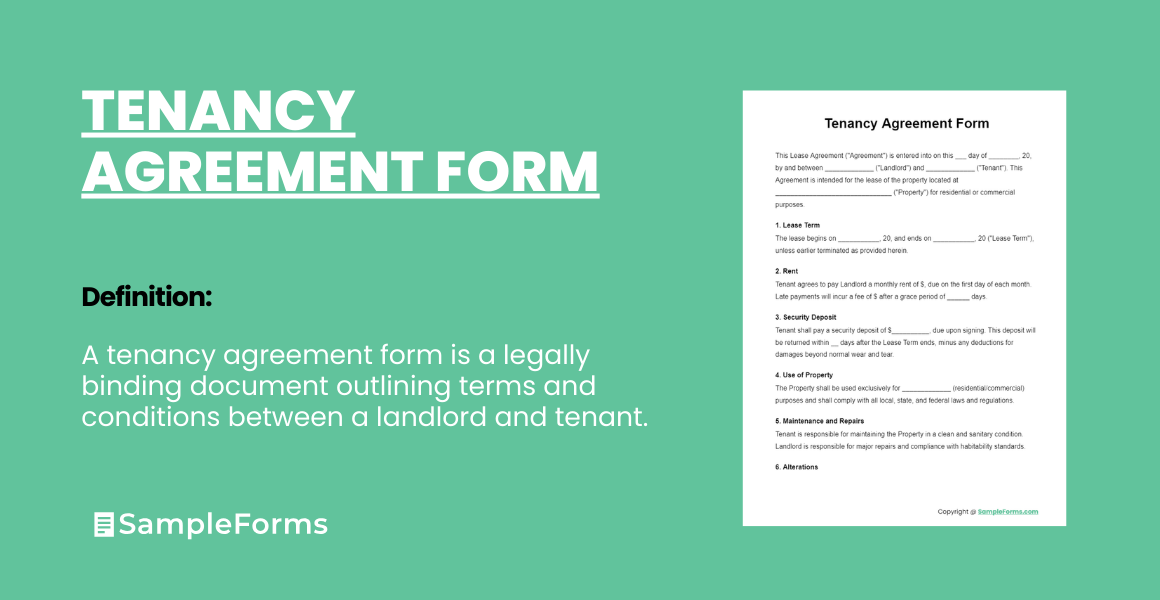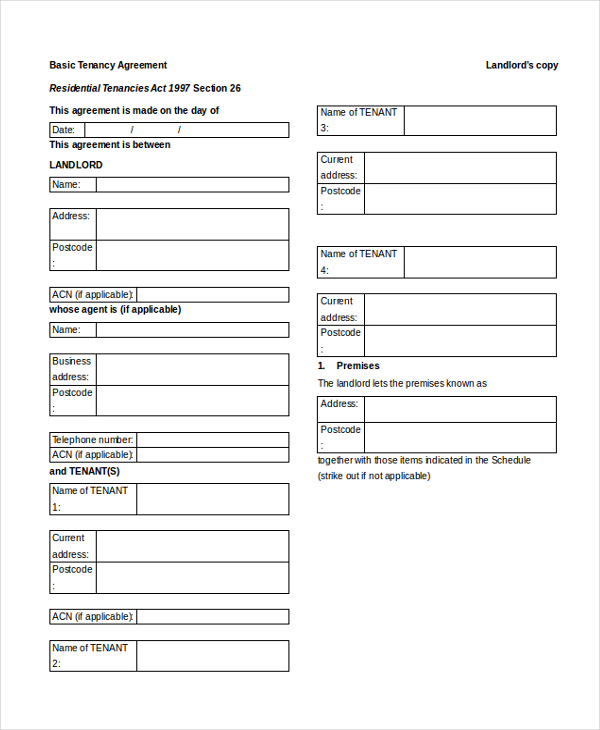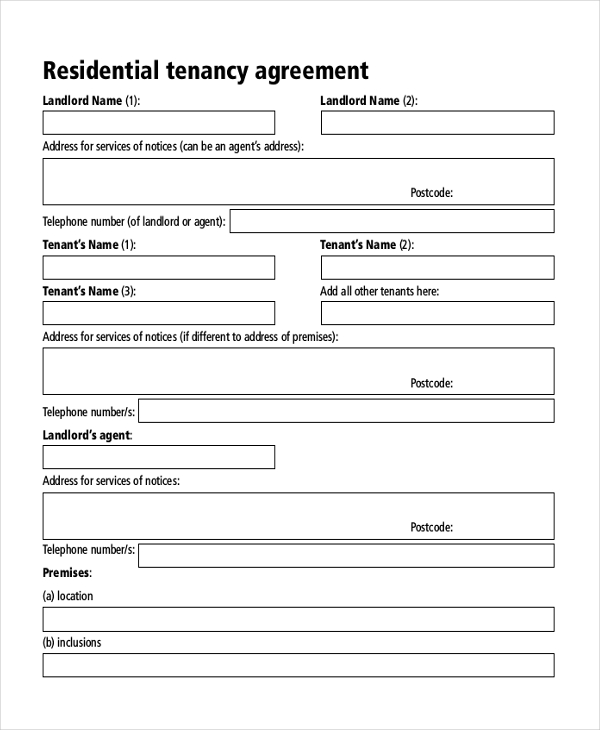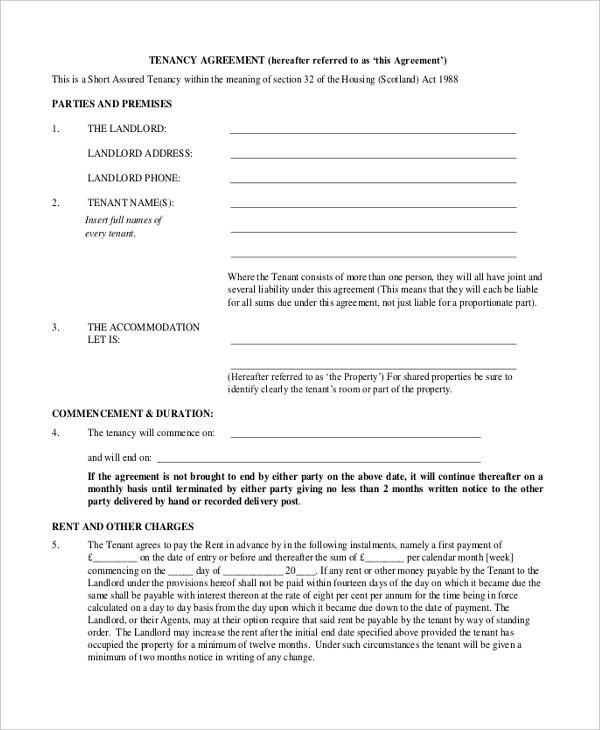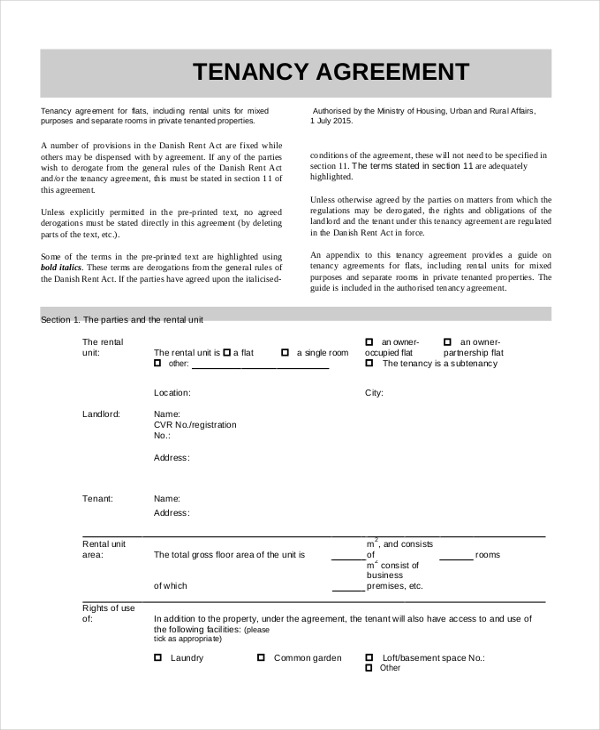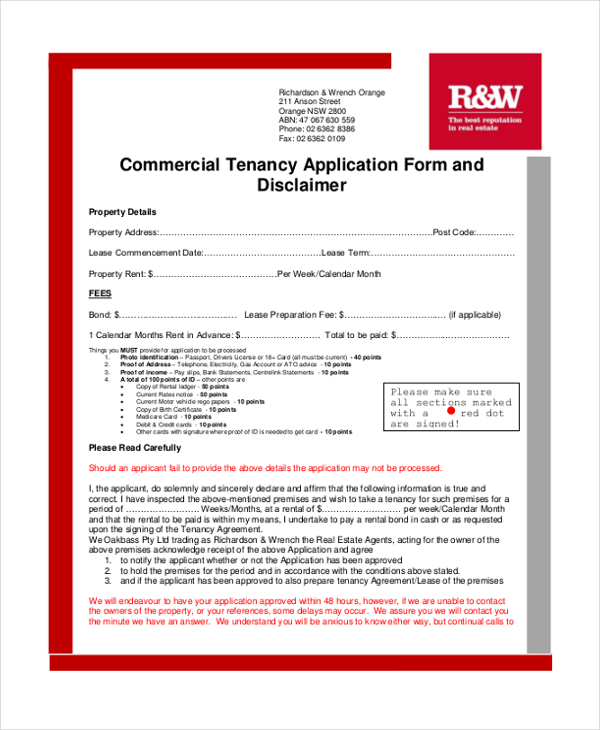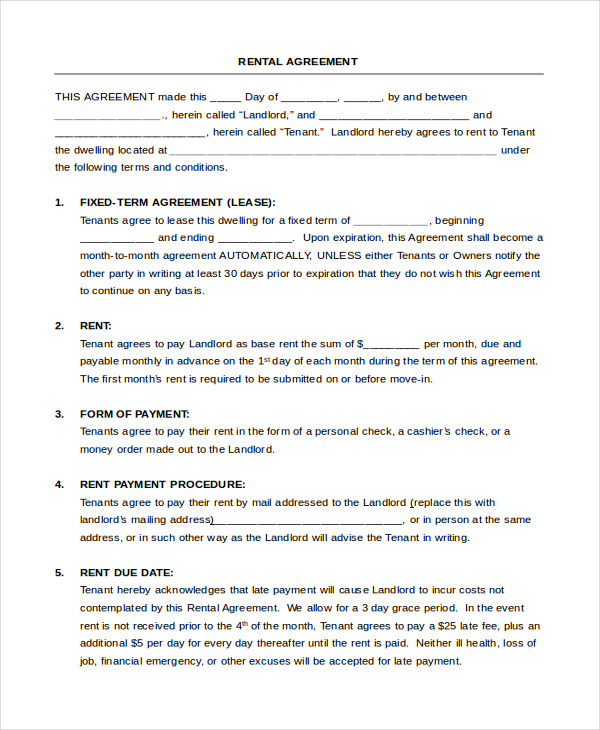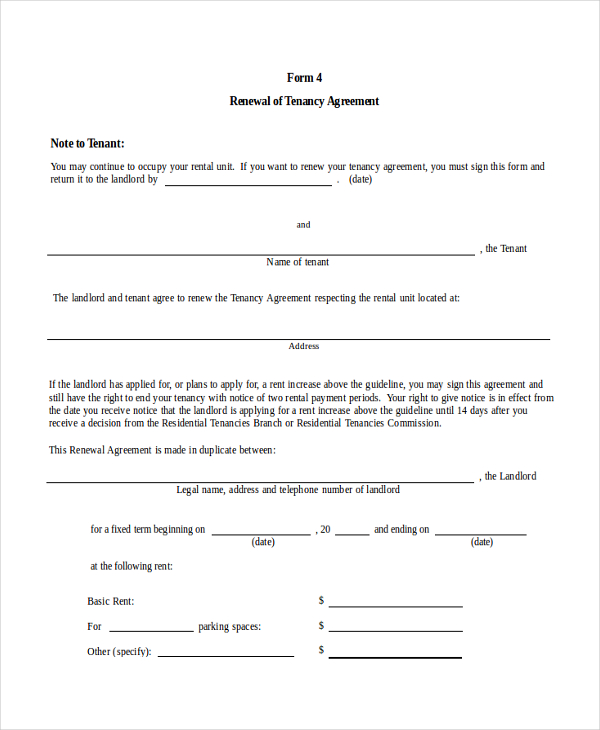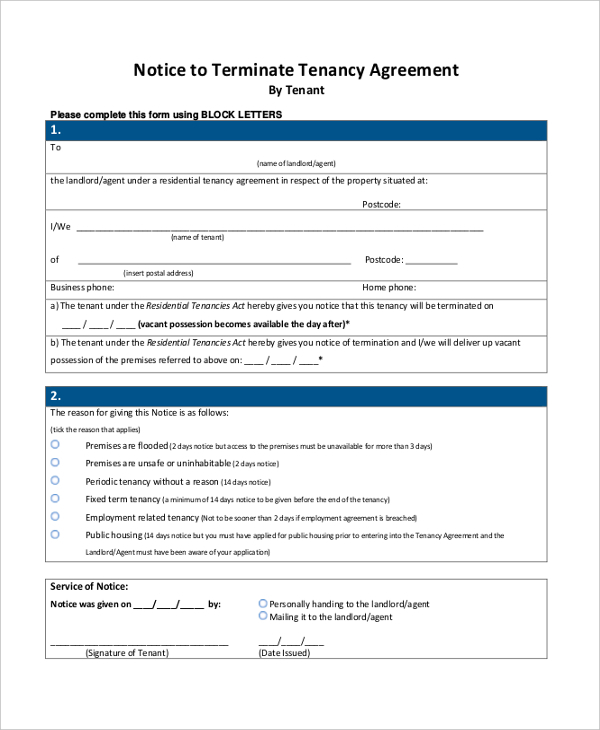Navigating the world of property rentals just got easier with our comprehensive guide to Tenancy Agreement Forms. This invaluable resource is packed with Sample Agreement Form, offering clear insights into rental and lease agreements tailored for landlords and tenants alike. Whether you’re drafting a Lease Agreement Form in Word or seeking a foolproof Rental Agreement Form, our guide simplifies the process, ensuring you’re well-equipped with the knowledge to create effective, legally sound agreements.
What is a Tenancy Agreement Form?
A Tenancy Agreement Form is a legally binding contract between a landlord and tenant that outlines the terms and conditions of renting property. This document is crucial for both parties, ensuring clarity on rent amount, lease duration, security deposit details, and the rights and obligations of each party. Whether you’re looking into a Sample Agreement Form, a Rental Agreement Form, or drafting a Lease Agreement Form in Word, understanding the fundamentals of a Tenancy Agreement is key to a smooth rental experience.
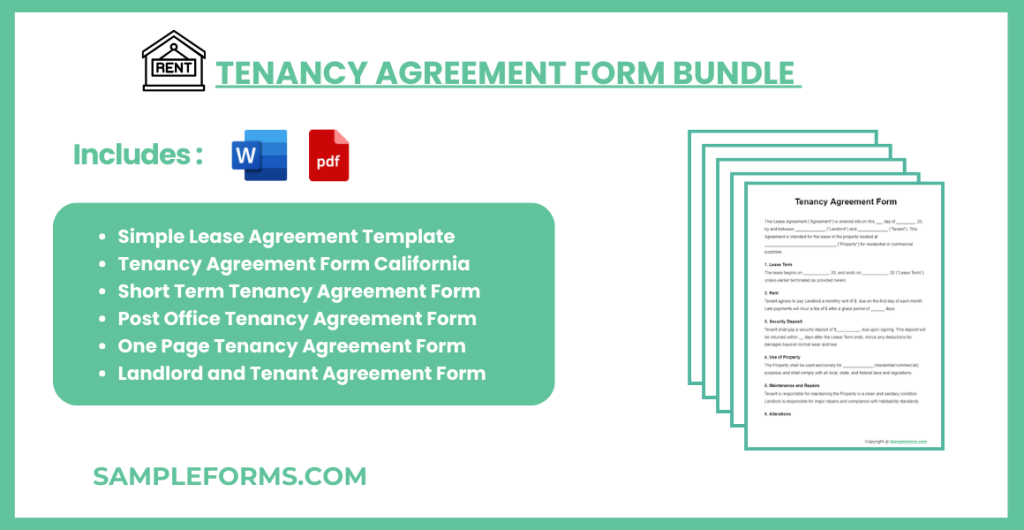
Download Tenancy Agreement Form Bundle
Rental Agreement Form Format
This Rental Agreement is made on [Date] between [Landlord’s Full Name], herein referred to as the “Landlord”, and [Tenant’s Full Name], herein referred to as the “Tenant”.
1. Property Details
- Address: [Property Address]
- Type of Property: [Apartment/ House/ Other]
2. Term of Lease
- Start Date: [Start Date]
- End Date: [End Date] (? Fixed Term ? Month-to-Month)
3. Monthly Rent
- Amount: $[Rent Amount]
- Due Date: [Due Date each month]
- Late Fee: $[Late Fee Amount] after [Number of Days] days late
4. Security Deposit
- Amount: $[Deposit Amount]
- The deposit will be returned within [Number of Days] days after the Tenancy ends, subject to the property being left in satisfactory condition.
5. Use of Property
- The Property is to be used solely as a private residence for the Tenant(s) listed:
- [Tenant Name(s)]
- Occupancy by more than [Number of Allowed Occupants] is prohibited.
6. Utilities and Services
- Tenant is responsible for the payment of the following utilities: [List of Tenant’s Utilities]
- Landlord is responsible for the payment of the following utilities: [List of Landlord’s Utilities]
7. Maintenance and Repairs
- The Tenant agrees to keep the leased premises in good order and condition and to immediately report any damage or need for repairs to the Landlord.
8. Alterations
- The Tenant shall not make any alterations, additions, or improvements without the prior written consent of the Landlord.
9. Pets
- ? Pets are allowed (Pet Deposit: $[Amount])
- ? No pets are allowed
10. Smoking Policy
- ? Smoking is allowed
- ? Smoking is not allowed
11. Governing Law
- This Agreement shall be governed by and construed in accordance with the laws of [State/Country].
12. Additional Terms and Conditions
- [Any other agreements, conditions, restrictions or permissions]
13. Signatures
- This Agreement, entered into the day and year first above written, binds the Tenant and the Landlord to its terms and conditions.
Landlord’s Signature: _________________________ Date: _____________
Tenant’s Signature: _________________________ Date: _____________
Simple Lease Agreement Template
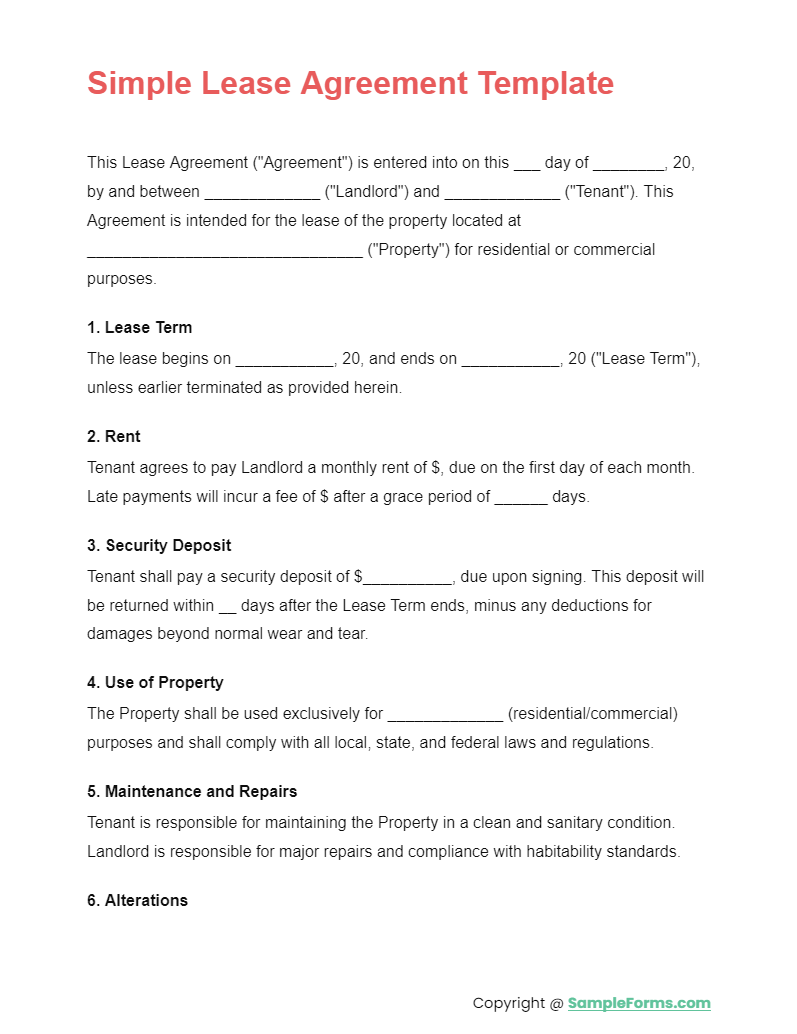
A Simple Lease Agreement Template streamlines the rental process, integrating Tenancy Application Form, and Tenancy Deposit Form, ensuring clarity and legal compliance for both parties in a straightforward document.
Tenancy Agreement Form California
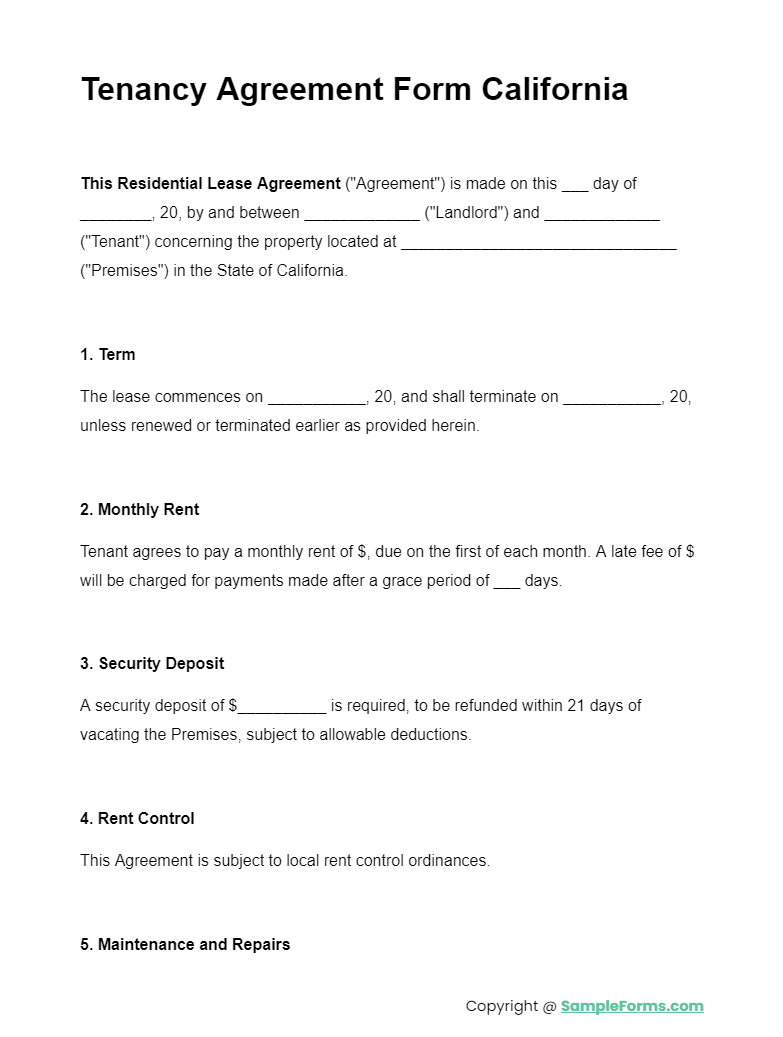
The Tenancy Agreement Form California caters to specific state requirements, including a Rental Agreement Letter and Room Rental Agreement, providing a comprehensive legal framework for landlords and tenants.
Short Term Tenancy Agreement Form

Ideal for brief leases, the Short Term Tenancy Agreement Form combines the flexibility of an Apartment Rental Agreement Form with the convenience of a Rental Agreement Month to Month, tailored for transient occupancy.
Post Office Tenancy Agreement Form
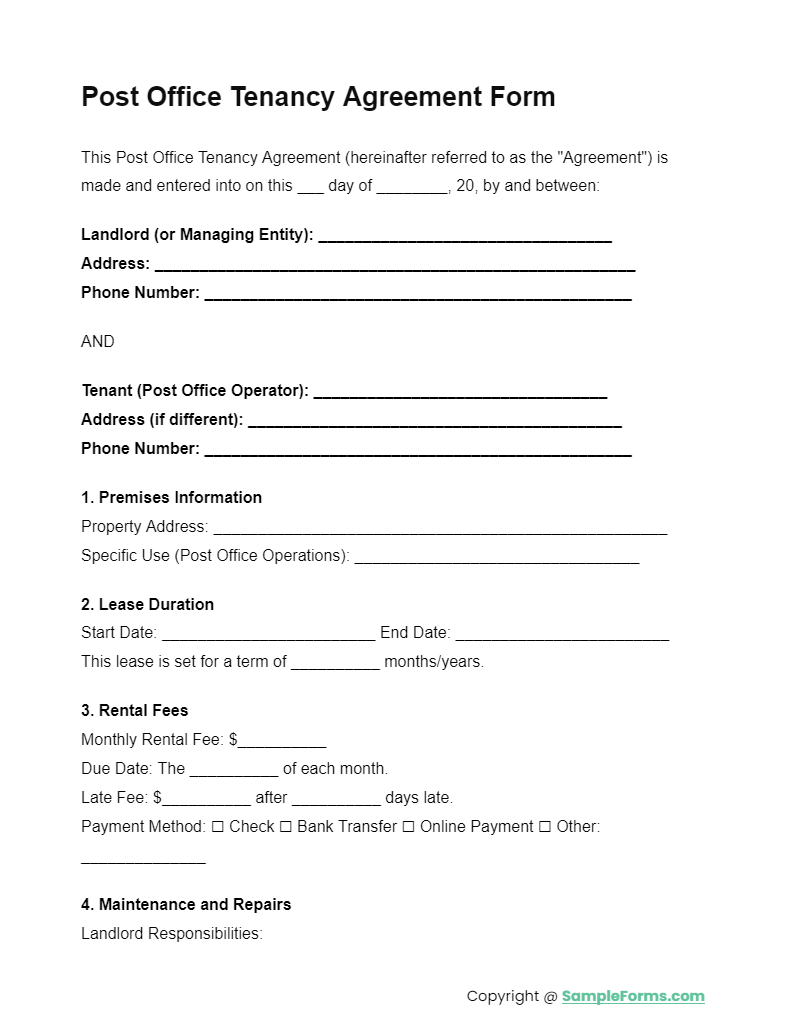
The Post Office Tenancy Agreement Form, often used for business rentals like a Salon Booth, includes a Rental Contract Form and Salon Booth Rental Agreement Form, offering a standardized approach to commercial leases.
One Page Tenancy Agreement Form
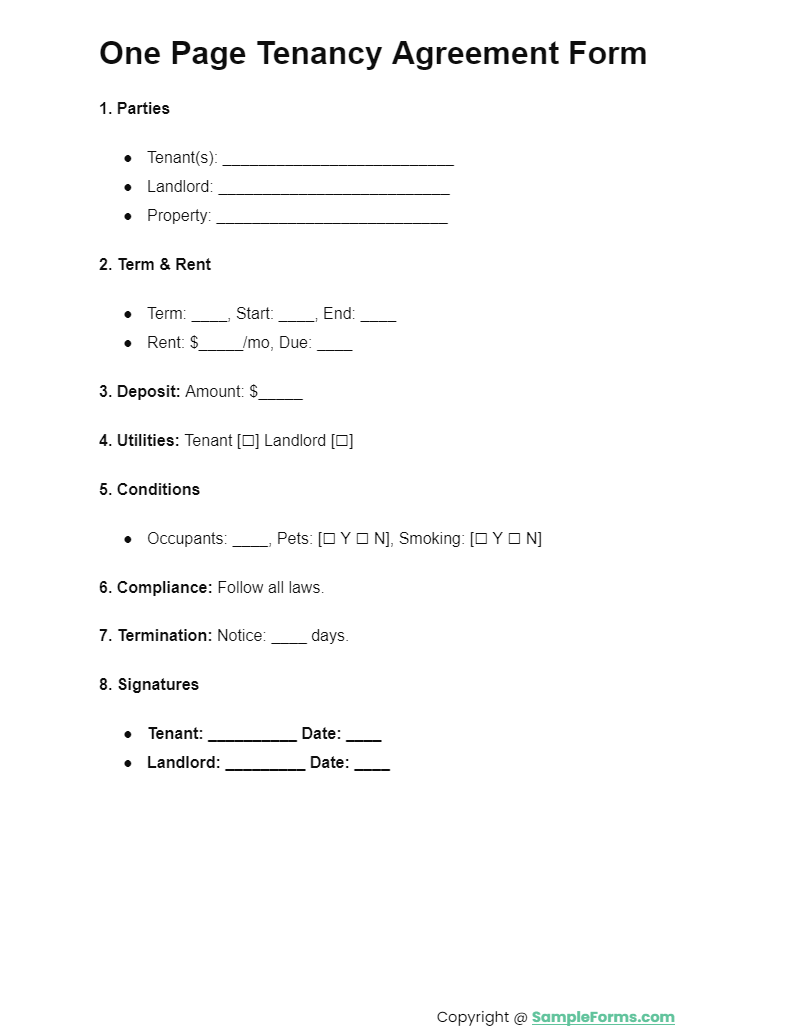
The One Page Tenancy Agreement Form simplifies the rental agreement process, accommodating Garage Parking Rental Agreement Form and Vacation Rental Agreement Form, making it perfect for short-term and specialized rentals.
Landlord and Tenant Agreement Form
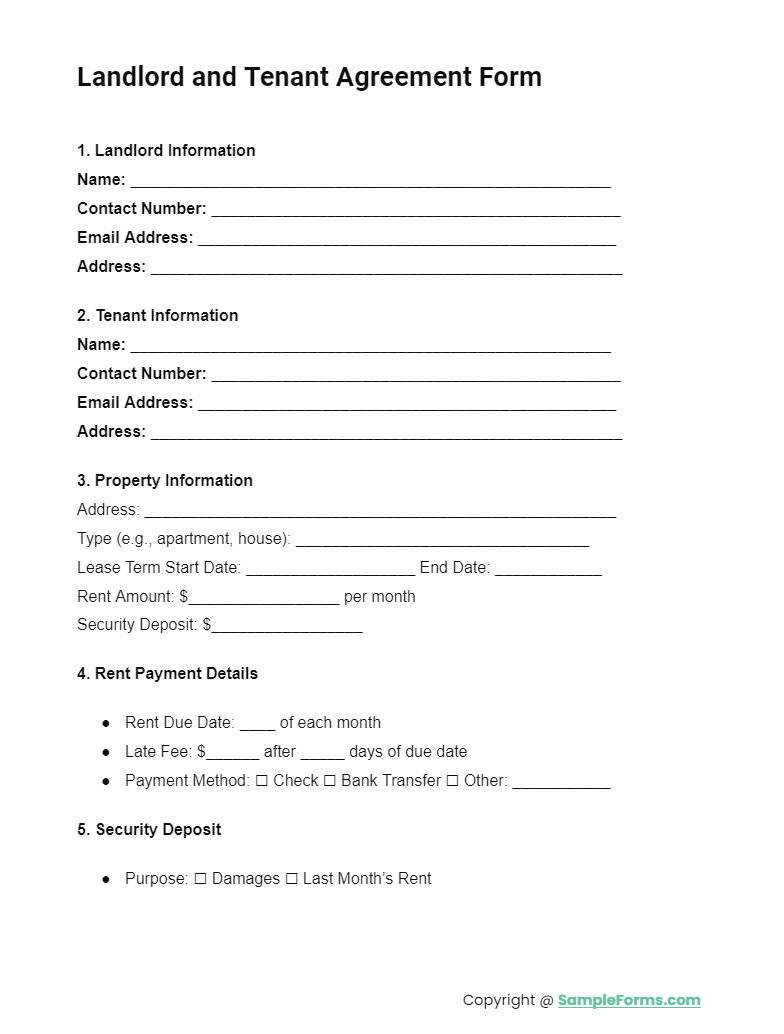
More Tenancy Agreement Form Samples
Tenancy Agreement Sample
This tenancy agreement form is free of cost and can be used to draft an agreement which should then be signed by the property owner and the tenant. With all the required segments and important clauses in place, the user can quickly draft a unique agreement for the purpose.
Tenancy Agreement Template Word
Tenancy Agreement PDF
When a residential property owner wishes to rent out his property to an interested tenant, he can use this form to draft a proper agreement. The form gives him a clear idea of the clauses to be included in the contract along with the essential segments.
Tenancy Agreement Form
This is a tenancy agreement form that has been issued by the government agencies to help people draft a tenancy contract. This form contains all the important clauses and segments. However, the user can alter these as per his needs and requirements.
Tenancy Agreement Sample PDF
As the name indicates, this is a standard design of a tenancy agreement form which can be used by any person irrespective of the kind of property he is willing to rent out. The form gives him an idea of the basic clauses to be included in such an agreement. You can also see Sample Rent Agreement Forms.
Commercial Tenancy Agreement Application Form
This form can be used by a person to offer his commercial property on rent to another person. The form gives the user an idea of the format to be followed and the segments to be included in the document. The clauses listed in the form safeguard the interests of both the parties involved.
Download Tenancy Agreement Form
A person who wishes to offer his property on rent can use this form to draft a proper tenancy agreement. With all the required clauses and segments in place, the user can quickly draft a unique tenancy agreement to be signed by him and the tenant. You may also see Sample Residential Agreement Forms.
Renewal of Tenancy Agreement
When a tenant wishes to request a property owner to renew the rental agreement he can use this document to draft such a request. This document gives him an idea of the right way to put in the request and the other essential details to be included.
Notice to Terminate Tenancy Agreement
A property owner can use this form to issue a notice to his tenant about terminating the tenancy agreement. In this form, the user is required to state the reason for the termination and the amount of notice period is willing to offer. You can also see Sample Real Estate Agreement Forms.
How do you write a Tenancy Agreement?
Creating a Tenancy Agreement is essential for establishing a clear and legal rental arrangement. This guide outlines the key steps to drafting an effective agreement, including elements such as the, Rental Receipt, and House Rental Contract.
Begin with Basic Details
Identify the landlord and tenant(s) with full names and contact information. Describe the rental property accurately, including its address and any specifics, like inclusions for a Trailer Rental Agreement Form.
Lease Terms
State the lease type (fixed-term or month-to-month) and duration, e.g., a one-year House Rental Contract from January 1 to December 31.
Rent and Payments
Specify the monthly rent, due date, and acceptable payment methods. Mention late fees and the provision of a Rental Receipt for each payment.
Security Deposit
Detail the security deposit amount and return conditions, including deductions for repairs or cleaning.
Maintenance Responsibilities
Clarify who is responsible for maintenance and repairs, ensuring both parties know their obligations.
Rules and Permissions
Include any restrictions, such as pet policies or no smoking, and the process for alterations to the property.
Legal Clauses
Ensure the agreement complies with all relevant laws, including occupancy regulations and rent control, if applicable.
Signatures
End with a section for both the landlord and tenant to sign, indicating agreement to the terms.
Simplify Language
Use clear, straightforward language and organize the agreement with headings and bullet points for easy reading. Consider a legal review for complex terms or conditions.
What are the Benefits of Using Tenancy Agreement Form?
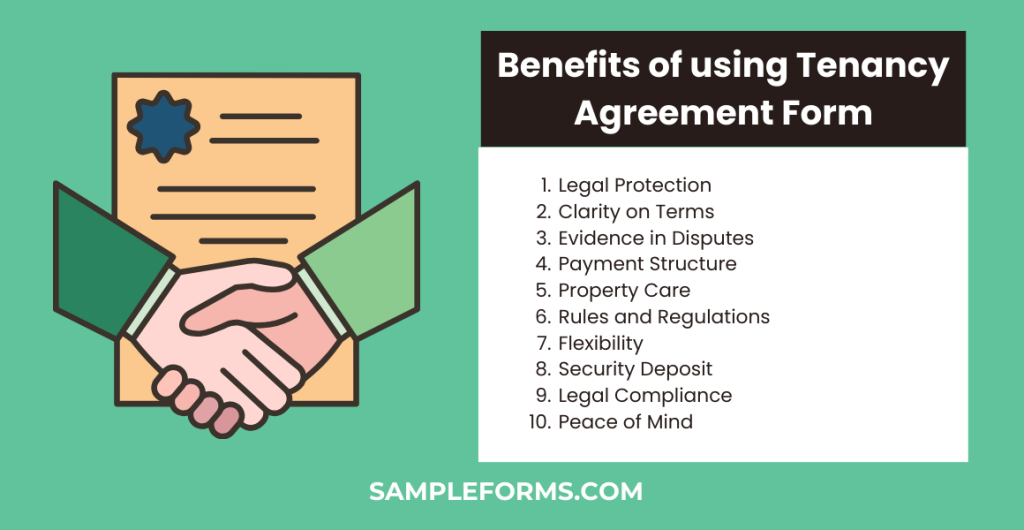
- Legal Protection: Ensures both landlord and tenant are protected under the law.
- Clarity on Terms: Clearly outlines rent, deposit, and lease term, preventing misunderstandings.
- Evidence in Disputes: Acts as a legal document in case of disputes between parties.
- Payment Structure: Specifies payment amounts, due dates, and late fees.
- Property Care: Defines responsibilities for maintenance and repairs, ensuring property care.
- Rules and Regulations: Establishes rules regarding pets, smoking, and use of property.
- Flexibility: Allows customization to suit specific landlord and tenant needs.
- Security Deposit: Details security deposit terms, protecting both party’s financial interests.
- Legal Compliance: Ensures the agreement adheres to local, state, and federal laws.
- Peace of Mind: Provides a sense of security and stability for both parties.
Not sure how to design a tenancy agreement? Fret not. Just check out our wide range of tenancy agreement forms and tenant application forms to pick one that would be apt for you. These forms can be easily downloaded and customized, thus helping you to save a lot of your time. You can also see Sample Sales Agreement Forms.
What is the difference between a Lease Form and a Tenancy Form?
| Aspect | Lease Form | Tenancy Form |
|---|---|---|
| Definition | A lease form is a contract that outlines the terms of a long-term rental, typically for a fixed period, such as one year or more. | A tenancy form generally refers to agreements for both short-term and periodic (month-to-month) rentals. |
| Duration | Usually for a fixed term with a start and end date. | Can be for a fixed term but often used for periodic tenancies without a specific end date. |
| Renewal | At the end of the lease term, the lease may be renewed or will otherwise expire. | Tenancies, especially periodic ones, automatically renew until proper notice is given. |
| Termination | Typically requires a notice before the end of the term if not renewing. | Can usually be terminated by either party with appropriate notice, often one month. |
| Rent Stability | Rent is often fixed for the duration of the lease term. | Rent may be subject to change if notice is given according to the agreement or local laws. |
| Use | Common for residential and commercial properties. | Primarily used for residential properties. |
| Legal Formality | Leases are often more formal and detailed due to their longer duration. | Tenancy forms can be less formal, especially for month-to-month arrangements. |
| Flexibility | Less flexible, as the terms are fixed for the duration of the lease. | More flexible, particularly with periodic tenancies allowing for changes with proper notice. |
| Security of Tenure | Provides more security of tenure due to the fixed term. | Less security of tenure, especially in a month-to-month tenancy. |
It’s important to note that the terms “lease” and “tenancy” can be used interchangeably in some regions, and the legal implications of each may vary depending on local laws. Always consult with a legal professional for advice specific to your situation.
What is the purpose of a Tenancy Agreement Form?
A Tenancy Agreement Form serves several key purposes:
- Legal Documentation: It provides a legally binding document that outlines the rights and responsibilities of both the landlord and the tenant.
- Clarity of Terms: It clearly states the terms of the tenancy, including rent, deposit, duration, and any other specific conditions agreed upon.
- Protection for Both Parties: It protects both the landlord and the tenant by setting out the legal parameters of their relationship, helping to prevent misunderstandings and disputes.
- Evidence of Agreement: It acts as evidence of the agreement made between the landlord and tenant should any legal issues arise.
- Property Management: It outlines the expectations for property maintenance and the use of the property.
- Compliance with Laws: It ensures that both parties are aware of and comply with local housing laws and regulations.
- Financial Terms: It details the financial obligations of the tenant, including rent, security deposit, and any other charges.
- Procedure for Dispute Resolution: It may include methods for resolving any disagreements that may occur during the tenancy.
- Instructions for Renewal or Termination: It provides instructions on how the agreement can be renewed or terminated, including notice periods and conditions.
- Inventory and Condition: It can include an inventory list and the condition of the property at the time of moving in, which is useful for managing the return of the security deposit at the end of the tenancy.
A well-crafted Tenancy Agreement Form is essential for a smooth landlord-tenant relationship and serves as a foundation for the tenancy. You also browse our Rental Deposit Form. Tenancy agreement forms can be used by people who may be interested in renting out of properties. Thus the target audience for these forms is
- Residential property owners
- Commercial property owners
- Apartment owners
- Landowners
- Real estate agents
- Tenants
- Lawyers
What is a Contract of Tenancy Form?
A Contract of Tenancy Form, also known as a Rental Agreement or Lease Agreement form, is a legally binding document between a landlord and tenant. It outlines the terms and conditions under which the tenant is permitted to rent a property from the landlord. Key elements include:
- Duration of Tenancy: Specifies whether it’s a fixed-term lease or a rolling monthly agreement.
- Rental Amount: States the rent cost, due dates, and payment method.
- Security Deposit: Details the deposit amount and conditions for its return.
- Property Description: Identifies the rental property’s address and features.
- Tenant and Landlord Obligations: Clarifies maintenance duties and property rules.
- Termination Conditions: Explains how either party may terminate the agreement.
- Legal Clauses: Includes clauses on late payments, eviction procedures, and other legal considerations.
This form serves as the foundation for the rental relationship, ensuring clear communication and understanding of each party’s rights and responsibilities.
Does California have a Standard Rental Agreement?
Yes, California offers a standard Rental Application, ensuring landlords and tenants have a clear, comprehensive agreement for residential leases.
What is the Most Common Type of Tenancy?
The most common type of tenancy involves a Parking Space Rental Agreement Form, reflecting the high demand for designated parking areas.
What a landlord Cannot do in California?
In California, a landlord cannot unjustly deny a House Rental Application or discriminate against prospective tenants, ensuring fair housing practices.
What makes a rental agreement legal in California?
A legal rental agreement in California requires a Rental History Form, signatures from all parties, and adherence to state-specific rental laws.
What is the new rental law in California?
The new rental law in California, affecting the Rental Agreement, includes rent control measures and enhanced tenant protections against eviction.
Related Posts
-
FREE 50+ Mortgage Forms Download – How to Create Guide, Tips
-
FREE 4+ Real Estate Listing Information Forms in PDF | MS Word
-
FREE 7+ Garage (Parking) Rental Agreement Forms in PDF | MS Word
-
FREE 7+ Office Lease Agreement Forms in PDF | MS Word
-
FREE 4+ Salon Booth Rental Agreement Forms in PDF | MS Word
-
FREE 5+ Roommate Rental Agreement Forms in PDF | MS Word
-
Electrical Subcontractor Agreement Form
-
FREE 10+Non-Disclosure Forms in PDF | MS Word
-
FREE 5+ Construction Subcontractor Agreement Forms in PDF | MS Word
-
FREE 5+ Real Estate Lease Guarantee Co-Signer Agreement Forms in PDF | MS Word
-
FREE 5+ Lease with an Option to Purchase Agreement Forms in PDF | MS Word
-
FREE 7+ Realtors Lease Agreement Forms in PDF
-
FREE 10+ Subordination Agreement Forms in PDF | MS Word
-
FREE 10+ Condominium Lease Agreement Forms in PDF | MS Word
-
FREE 5+ Lottery Agreement Forms in PDF | MS Word
